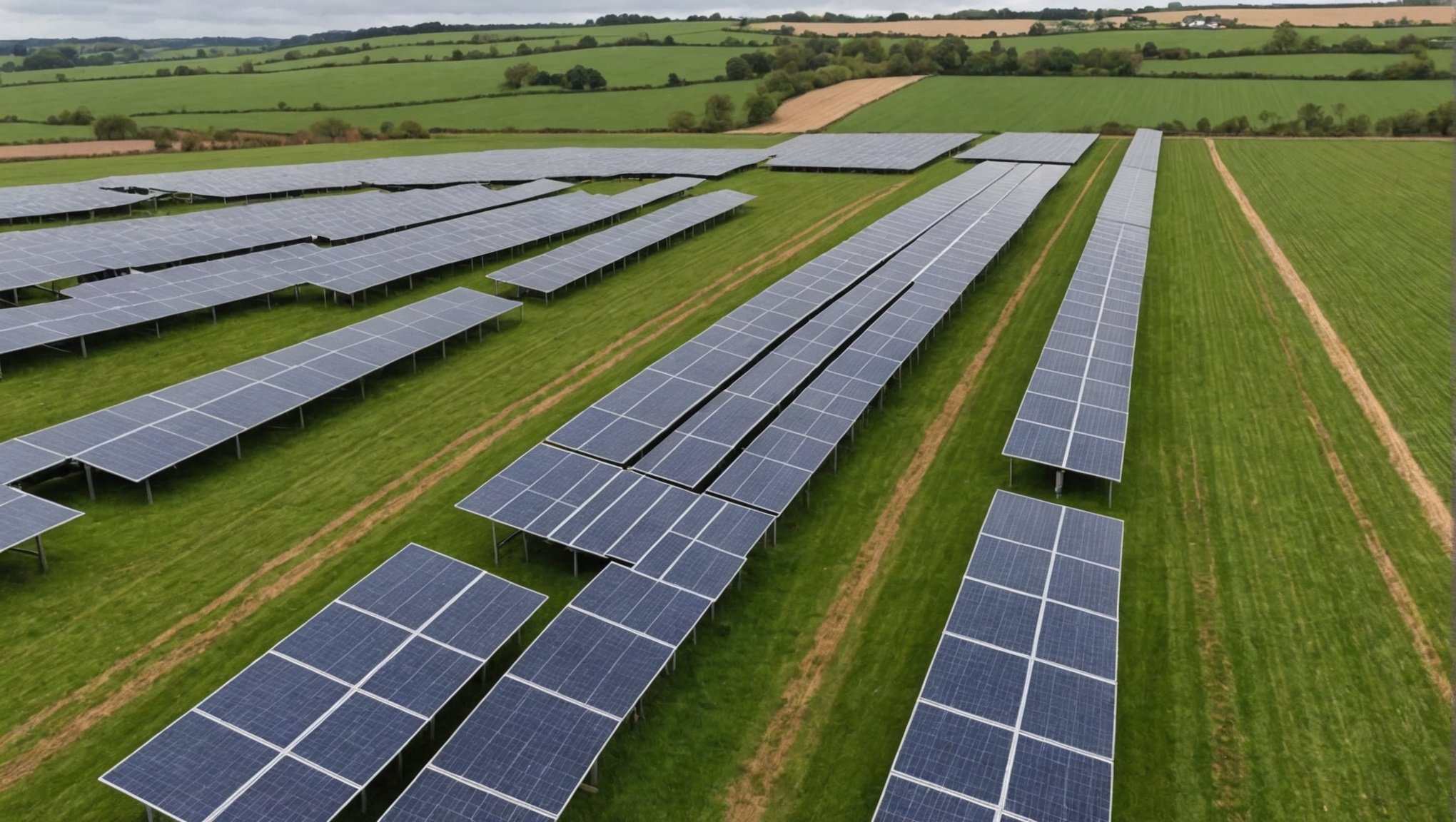Understanding Hybrid Renewable Energy Solutions
Hybrid renewable energy systems have emerged as a revolutionary response to rural energy demands. These systems integrate multiple renewable technologies—such as solar, wind, and biomass—to create a cohesive power generation strategy. By combining different sources, hybrid systems harness the strengths of each while mitigating their individual limitations. This ensures a more reliable and consistent energy supply compared to singular systems.
Components and Technologies
Solar technology captures sunlight through photovoltaic cells, converting it into electricity. Wind systems generate energy using turbines powered by air currents, an ideal supplement during less sunny periods or at night. Biomass energy, derived from organic materials, offers a versatile and localised option, converting waste into power and reducing environmental impact.
In parallel : Exploring How Modular Housing Can Alleviate the UK”s Urban Housing Crisis: Key Benefits Uncovered
Combining these technologies in a hybrid system marries the intermittency issues of solar and wind energy with the reliability of biomass. The synergy allows energy supply consistency, even in isolated rural areas. Hybrid renewable technologies are particularly valuable where traditional grid access is limited, providing localised and sustainable power solutions.
Rural energy solutions significantly improve with hybrid systems, enriching community livelihoods. They facilitate energy access for essential services such as refrigeration, lighting, and water pumping, promoting economic development and quality of life. As a resilient, adaptable, and eco-conscious option, hybrid solutions are crucial for powering the future of rural areas efficiently.
Also to discover : Mastering the New Landscape of UK Immigration: A Comprehensive Guide to Policies and Procedures
Benefits of Hybrid Renewable Energy in Rural UK Communities
Rural communities across the UK stand to gain a plethora of advantages by adopting hybrid renewable energy systems. One of the foremost benefits is the environmental advantage. These systems combine multiple sources of renewable energy, such as wind and solar, effectively reducing carbon emissions and promoting sustainability. By doing so, they contribute to rural support in fighting climate change, preserving natural landscapes that define the UK countryside.
From an economic perspective, hybrid renewable energy can usher in job creation and lessen energy costs for these communities. Installing and maintaining such systems require skilled labour, thus providing new employment opportunities. Additionally, the decreased dependency on fossil fuels translates to lower energy bills, allowing residents to reallocate savings into local rural development initiatives.
The energy independence that these systems offer is another significant advantage. By taking control of their energy production, rural areas bolster their energy security, ensuring a stable and reliable energy supply. This independence can protect communities from market volatility or supply issues that sometimes affect non-renewable energy sources. Consequently, hybrid renewable systems not only enhance rural resilience but also empower local development, providing a practical and sustainable solution to traditional energy challenges.
Case Studies of Successful Implementation
Exploring successful case studies in energy projects offers valuable insights into practical applications. Communities worldwide have demonstrated exceptional innovation through rural energy projects that harness unique approaches.
Case Study: Community A’s Solar-Wind Hybrid System
Community A has successfully implemented a solar-wind hybrid energy system, showcasing remarkable synergy between these energy sources. By integrating photovoltaic panels with wind turbines, this project has significantly reduced reliance on traditional energy forms. The community reports a nearly 60% increase in energy production efficiency. Not only does this hybrid system provide a stable and reliable energy supply throughout the year, but it also enhances the local economy by reducing energy costs.
Case Study: Community B’s Biomass Integration
In Community B, biomass integration has become a central part of their energy solutions. By converting agricultural waste into energy, they have not only addressed waste disposal issues but also achieved sustainability. Economic benefits include job creation in biomass processing facilities and substantial savings compared to former energy technologies.
Case Study: Community C’s Combined Approach
Community C has taken a holistic stance with a combined approach involving solar, wind, and biomass. This approach maximises energy production and establishes a model of efficiency. Residents have observed a marked improvement in energy security and cost-effectiveness, fostering economic growth. Such hybrid energy examples serve as blueprints for other rural areas aiming for sustainable development.
Funding and Support for Hybrid Energy Projects
Navigating the landscape of funding for renewable energy can be daunting, but numerous opportunities exist for communities and enterprises aiming to develop hybrid energy projects. Both government and private sectors offer a variety of options tailored to facilitate these ventures.
Government funding plays a pivotal role through grants and subsidies, especially during the initial phases of a project. These financial aids are designed to alleviate the typically high upfront costs associated with hybrid energy developments, enabling smoother transitions to sustainable solutions. For instance, various national and local programs aim to fuel rural energy investments, ensuring that these areas can access clean, reliable power sources.
In addition to governmental assistance, private funding entities are increasingly investing in renewable energy initiatives. Corporations and venture capitalists are drawn to the sector by its immense potential for innovation and profitability. This diverse funding ecosystem underscores the importance of securing the necessary resources at different stages of development.
Communities seeking financial support for hybrid projects can leverage numerous resources. Websites such as governmental energy departments offer comprehensive information on available grants, subsidies, and loans. Additionally, partnerships with industrial stakeholders provide strategic insights and possibly even financial backing to propel community energy projects forward. These collaborations are invaluable in bridging the gap between concept and realization.
Implementation Strategies for Rural Communities
Successful implementation of hybrid energy projects within rural communities requires meticulous planning and adept project management. The first and foremost step is conducting a comprehensive needs assessment, which identifies specific energy demands of the community. This assessment guides the direction and scale of the project.
Following the assessment, establishing clear communication channels with all stakeholders is crucial. Engaging the community early and involving them in decision-making fosters ownership and acceptance. By incorporating local insights and expertise, projects are more tailored and effective. Stakeholder involvement, including local leaders, energy providers, and governmental bodies, ensures that all voices are heard, and diverse perspectives are considered.
Regulatory and planning challenges may pose significant hurdles. Navigating these challenges requires understanding local laws and regulations. Collaborating with local authorities helps streamline the process, avoiding potential delays and legal challenges. Tailored strategies might include seeking out capacity-building opportunities for local project managers to effectively align projects with regulatory frameworks.
In conclusion, marrying project management principles with nuanced community integration strategies leads to successful rural energy integration. Through a blend of judicious planning, active community participation, and regulatory foresight, hybrid energy projects can be deployed effectively, providing sustainable and reliable energy solutions to rural areas.
Cost-Benefit Analysis of Hybrid Renewable Energy Solutions
In evaluating renewable energy systems, understanding the balance between initial investment and long-term savings is crucial, especially in rural settings. Economic assessments often illustrate how, despite substantial upfront costs, hybrid renewable energy solutions can lead to significant savings over time. The integration of technologies such as solar and wind reduces reliance on traditional energy sources, enhancing sustainability and cost-efficiency.
From an environmental standpoint, hybrid systems offer a compelling case. Reducing carbon emissions not only aligns with global climate goals but also contributes to better air quality locally, delivering both ecological and public health benefits. Furthermore, these systems enhance energy security by diversifying energy sources, thus diminishing the potential impacts of energy supply disruptions.
Socially, the adoption of renewable energy in rural areas can catalyse economic growth. By providing more reliable energy access, communities can develop local industries and improve living conditions. This shift also has the potential to create job opportunities in installation and maintenance, fostering local skill development.
When compared to traditional energy sources, hybrid renewable solutions present a promising alternative. Despite higher initial investments, the ongoing savings, combined with the environmental and social advantages, make these solutions a favourable option from a comprehensive cost-benefit analysis perspective.
Challenges and Solutions in Adopting Hybrid Energy
The adoption of hybrid energy systems can transform rural areas, yet several challenges persist. Limited infrastructure is a major barrier, often impeding the deployment of these systems. Rural regions frequently lack the necessary grid connections and maintenance capabilities, making it difficult to integrate renewable technologies effectively. Moreover, financial constraints and limited access to capital can deter investments in hybrid energy, leaving communities reliant on traditional, less sustainable sources.
Overcoming these barriers requires tailored solutions and innovative approaches. Financial mechanisms, such as government subsidies or incentives, can alleviate initial investment hurdles, encouraging the switch to a more sustainable energy mix. Additionally, community involvement in decision-making processes can foster a sense of ownership and commitment to maintenance and operation, ensuring longevity and effectiveness of systems.
Technological innovation plays a pivotal role in addressing these challenges. Advances in energy storage and grid management allow for more resilient and adaptive networks, better suited to rural needs. Decentralized grid systems can provide flexibility, enabling communities to harness local resources efficiently. Moreover, emerging technologies can lower installation costs, making hybrid energy accessible to broader demographics and bridging the rural-urban energy divide.
Future Trends in Hybrid Renewable Energy for Rural Areas
The future of hybrid renewable energy features exciting prospects, particularly in rural areas. Emerging technologies promise to change the landscape of rural energy provision. For instance, advancements in solar and wind technologies are showing considerable potential. These technologies are becoming increasingly efficient and affordable, making them viable options for sustainable energy production in areas previously deemed unsuitable.
Predictions point towards significant market growth in the renewable sector, driven by necessary policy changes aimed at reducing carbon footprints globally. Government initiatives and incentives are set to encourage both large corporations and small communities to adopt more sustainable practices. As demand for clean energy rises, private investors will likely follow suit, ensuring further innovation and accessibility.
Furthermore, the role of community-led energy initiatives is evolving, becoming a cornerstone of rural energy futures. Such initiatives empower locals through involvement in energy production, fostering a sense of ownership. They enhance resilience against fluctuating energy prices and improve energy access reliability.
In summary, the combination of technological innovation, market dynamics, and community-led initiatives heralds a promising horizon for renewable energy in rural settings, ensuring these areas keep pace with global energy sustainability trends.













